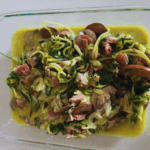This post is Day 9 Backpacking the SHT continues my journey on the Superior Hiking Trail with a chronic condition called Mast Cell Activation Syndrome (MCAS).
Table of Contents
What is MCAS?
Mast Cell Activation Syndrome (MCAS) is a chronic condition that affects all organ systems. MCAS is serious and disabling and people with MCAS experience often significant and debilitating symptoms daily, including anaphylaxis, which can be fatal.
MCAS is often found in combination with other chronic conditions such as Ehlers-Danlos Syndrome (EDS) and Postural Orthostatic Tachycardia Syndrome (POTS).
Frequently healthcare providers do not know about MCAS, and the tests for MCAS are problematic because they are not uniformly reliable. MCAS can be difficult to manage. Treatments include blocking mast cell mediators with anti-histamines and mast cell stabilizers, as well as avoiding triggers.
Check out this post on how to manage MCAS.
Day 9 on the SHT – In the Weeds
The trail continued uphill for another mile and then the terrain leveled off as I entered a section with very dense vegetation. I’m 5’2″ and the plants along the trail were up to my chin, so it felt like I was swimming/slogging through because they were wet with dew. Burrs snagged on my bug suit and I had to stop frequently to pick them off. At times the trail was obscured by the vegetation, and I was so grateful when I reached patches where the trail was clearly delineated.
At a sunny daisy-strewn clearing where a forest service road crossed the trail I stopped for lunch and a brief rest. The bugs had been somewhat deterred from reaching my body when I was submerged in weeds, but now they attacked my ankles and wrists especially where there were gaps between the bug suit and my socks and gloves. So I kept my break short and continued on.
Not fighting the trail
The next section of the trail meandered through mature forests where the trail was rockier, and I noticed how much easier it was to progress when I wasn’t fighting against the vegetation. I came across two women on the trail hiking in the opposite direction, and that was my only human contact all day.
By mid-afternoon, I arrived at Bally Creek Pond, which I knew to be the only water source in the area. The area surrounding the pond was marshy, and there wasn’t clear access to the water, so I took off my shoes and socks and waded through the tall grass to the pond’s edge to fill my water reservoir. The cool water felt lovely on my toes!
I set up camp at the Bally Creek North campsite, where again I was the sole camper, and enjoyed my book in my tent. I’m reading the second book by Angeline Boulley called “Warrior Girl Unearthed.”
Why I love the SHT
One of the reasons I love doing the SHT is being immersed in nature’s healing influence. I notice that my inflammation goes down significantly when I am out in the middle of nowhere. Perhaps it is being away from EMFs and toxic fumes, or maybe it has to do with sweating out so many toxins (I’m a big sweater!!) Regardless, I love how I feel once I settle into my groove on the trail. While yesterday was a bit of a struggle, today I felt centered and peaceful the whole day, and my body was free of the discomforts that plague me at home.
Another reason that I love being on the SHT is that it affords me access to so many wild landscapes that are otherwise unavailable to ordinary folks. So much of the North Shore has been bought up by developers, where the lakeshore is barricaded by “no trespassing” signs, and for-profit businesses control who can experience the beauty that the area offers. While there are also lots of state parks on the North Shore, it’s gotten harder and harder to reserve camp spots in them. So, I’m so grateful to be able to hike this trail that traverses public and private lands, and I get to share in the majesty of the forests, lakes, ponds, rivers, and views. The campsites on the trail are available to hikers on a first-come, first-served basis, so there is always a little bit of uncertainty about camping. But besides the big group of campers yesterday, so far I’ve been virtually alone when I camp.
Freedom
Yet another reason that I love being on the SHT is how free I feel. Now that I’ve dialed in the gear in my pack, it feels so cool to be completely self-sufficient for several days at a time on the trail. I am free to roam, free to camp, and I am free to set my own schedule.
For many years as a caregiver — when it was actually impossible for me to leave my loved ones for more than an hour, or travel away from home as a family — I used my mind to visit wild spaces like this. In my meditations, I would spend time at lakes, beaches, and forests, wander along woodsy paths, and relish the warmth of the sunshine on my face. This practice saved me from the despair of caregiving when I felt physically trapped at home.
I’m so grateful I can physically do now what I could only do in my dreams before! My virtual visits to wild spaces filled me up with the beauty of nature when I couldn’t physically get there, but I’ve needed to be immersed in actual nature so badly. It feels like a homecoming to fulfill this need.
Today’s hike was about six miles in length. I’m finding that I can do longer stretches of the trail now, and tomorrow I hope to do my longest hike yet! Stay tuned!





The bucket theory
The bucket theory offers a helpful analogy for understanding symptom reactions with MCAS.
Think of your body as an empty bucket you want to keep from overflowing. Different foods and activities fill your histamine bucket at different speeds but they combine to form the total level of histamine in your body (how full your bucket is). A fuller bucket means you have more histamine symptoms. When you manage triggers, reduce exposure to known triggers, and take medications and supplements to reduce histamine, you can manage the level of your bucket.
Know your typical symptom progression
Knowing your symptom progression in a symptom flare is the key to developing your rescue plan. In this post, I discuss how to determine your symptom progression. Once you know what typically happens in your symptom progression you can design a rescue plan to address those symptoms.
Get my free ebook, symptom log, and meal plan!
Want a tool to keep track of your symptoms easily? Sign up for my newsletter and you will receive my free 50-page ebook of lower-histamine, grain-free, sugar-free recipes, my free symptom log, and a free two-week meal plan!
Sign up for the SSP!
The SSP is a listening therapy based on Polyvagal Theory created by Stephen Porges to unlock your ability to think, feel, and connect better through nervous system regulation. You use the SSP via an app on your phone and listen with over-the-ear headphones to specially filtered music that heals the nervous system, specifically the vagus nerve. You subscribe to the app with a provider like me and listen to the specially curated music for 30 minutes each day for a 5-hour cycle. Studies show the SSP has a profound effect on mental health and chronic conditions
You can sign up for the SSP here!
Order my book!
Rocks and Roots chronicles my journey solo backpacking the Superior Hiking Trail and overcoming nervous system dysregulation, gut dysbiosis, and Mast Cell Activation Syndrome symptoms to hike 328 miles successfully.
Check out this powerful frequency device
Healy is an individualized microcurrent device I use to reduce inflammation. Check out this post for more about Healy.
Sign up for a session!
I provide one-on-one in-person and remote chronic illness and caregiver coaching and Sacred Self-Healing Sessions based on the Sacred Self-Healing Method, a proven novel co-creative healing modality detailed in my Books.
Click here for more information.
What do you think?
I’d love to have your reply below!
Disclaimer
The preceding material does not constitute medical advice. This information is for information purposes only and is not intended to be a substitute for professional medical advice, diagnosis, cure or treatment. Always seek advice from your medical doctor.



